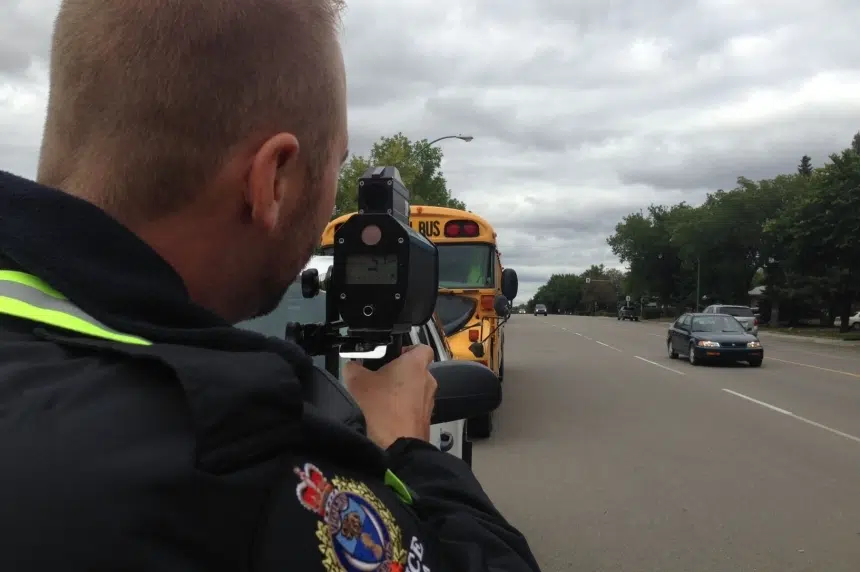If a car is travelling 30 kilometres per hour instead of 40 km/h through a school zone how much safer are your kids? Regina’s city council is studying that math problem ahead of the next school year.
As Regina students head back to class this week, drivers are reminded to pay closer attention in school zones. 980 CJME is taking a closer look at how school zones work in other western Canadian cities as the city considers changing.
Regina looks at change
In Regina, the speed limit in school zones is currently 40 km/h every day of the year between the hours of 8 a.m. and 10 p.m. A report by the Regina Traffic Zone Safety Committee is recommending subtracting that speed limit by 10 km/hr.
Norm Kyle is the director of roadways and transportation for the city and explained that report recommended switching the school zone speed limits to 30 km/h to be more consistent with other jurisdictions across North America. They would remain in effect year round, but the hours could be changed from 7 a.m. to 7 p.m.
“The biggest reason for the 30 km an hour is the survivability rate for vulnerable pedestrians – so young children and seniors,” Kyle explained, noting the committee looked at studies from across North America.
If council approves the change, the city would conduct a safety audit of all school zones to look at factors like how visible signs are along with issues around stopping, parking, crosswalks and the traffic control nearby.
“That’s in order to establish appropriate lengths of school zones and to provide the protection that’s needed,” Kyle said.
He said applying national safety standards would also mean accounting for the type of school in the review.
“So a high school would be treated somewhat differently than an elementary school because young elementary students are much more vulnerable, they’re sometimes less aware of their surroundings, whereas high school students are looked at as young adults – a lot of them are already driving to school,” Kyle explained.
If the proposed changes are passed by city council at the end of October, Kyle said it would take some time to complete a safety review and replace signs. Any change would only come into effect by the start of the next school year in the fall of 2019.
Saskatoon
In Saskatoon, the school zone speed limit is already 30 km/h between 8 a.m. and 5 p.m. from Monday to Friday through the school year from September to June.
Winnipeg
Winnipeg is very similar to Saskatoon with maximum speed limits of 30 km/h around many school zones between 7 a.m. and 5:30 p.m. But those speed limits are only enforced Monday to Friday September to June.
Calgary
In 2016 the City of Calgary changed all school zones into playground zones to make speed limits of 30 km/h consistent between 7:30 a.m. to 9 p.m. every day of the year. Before 2014, drivers were told to slow to 30 km/h in playground zones until ‘one hour after sunset’. According to Calgary’s city website 20 per cent of pedestrian collisions happened between 6 p.m. and 9 p.m.
Edmonton
Last year the City of Edmonton also turned school zones into playground zones in order to enforce the speed limit of 30 km/h year round. The hours of enforcement are now 7:30 a.m. to 9 p.m. The city website said extending enforcement hours later into the evening was based on protecting children who attend after-hours activities at schools and limiting confusion for drivers.
Is 30 safer?
Research published by the World Health Organization shows a pedestrian has a 90 per cent chance of surviving being hit by a car at a speed of 30 km/h or lower but only has a 50 per cent chance of surviving impact with a vehicle at speeds above 45 km/h. Studies also show slowing to 30 significantly shortens the distance drivers need to react and stop. Link:
‘No secret to school zones:’ Regina Traffic Officer
Const. Curtis Warner is a Regina police officer with the traffic division and he said too often drivers in the city play ignorant or “stick their head in the sand when it comes to school zones.”
“They might say well there’s no kids out on the playground, or there’s not school buses out so you guys shouldn’t be out there enforcing it,” Warner commented in an interview with the Greg Morgan Morning Show on 980 CJME at the end of August.
“The bulk of our schools – especially the elementary schools – all have playgrounds attached to them so it is reasonable to say that there could be kids in the area at that time.”
While there are proposals to change the time of enforcement and speed limit itself, Warner said “there’s no secret to school zones in our city.
“They’ve been 40 from 8 a.m. and 10 p.m. year round 365 days a year whether school is in or not.”
Enforcement and stats
September marks the start of SGI’s province-wide traffic safety blitz on school zones. While the rules may vary between cities, Regina police officers and all police forces across the province will be increasing enforcement in school zones.
According to the latest numbers available from SGI, there were 18,393 convictions for Saskatchewan drivers speeding through school zones in 2017. Photo radar tickets made up the majority of those with 14,703. This still marked a significant decrease from 2016, when SGI recorded 20,451 speeding convictions in school zones, including 17,283 photo radar tickets.
Between 2011 and 2017, 15 school-aged children were injured in crashes in school zones. The number of crashes varies widely with 15 in 2011, only five in 2013. In 2015 there were 27 crashes in school zones and in 2017 there were 20.











